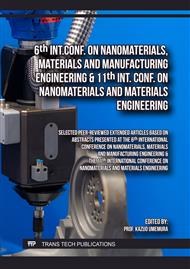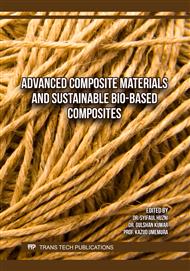[1]
Y. Yu, X. Huang, and W. Yu: A novel process to improve yield and mechanical performance of bamboo fiber reinforced composite via mechanical treatments. Composites Part B: Engineering, Vol. 56 (2014), pp.48-53.
DOI: 10.1016/j.compositesb.2013.08.007
Google Scholar
[2]
Y.S. Li, W. Shan, and R. Liu: Experimental study of mechanical behavior of bamboo- steel composite floor slabs. In Modern Bamboo Structures. (2008), pp.287-296. CRC Press.
DOI: 10.1201/9780203888926.ch31
Google Scholar
[3]
Y. Yu, Z. Jiang, B. Fei, G. Wang, and Wang, H: An improved microtensile technique for mechanical characterization of short plant fibers: a case study on bamboo fibers. Journal of Materials Science, Vol. 46 (2011), pp.739-746.
DOI: 10.1007/s10853-010-4806-8
Google Scholar
[4]
V. Kumar, P.K. Kushwaha, and R. Kumar: Impedance-spectroscopy analysis of oriented and mercerized bamboo fiber-reinforced epoxy composite. Journal of Materials Science, Vol. 46 (2011), pp .3445-3451.
DOI: 10.1007/s10853-011-5249-6
Google Scholar
[5]
K. Ohkita, and H, Takagi: Flexural properties of injection-molded bamboo/PBS composites. International Journal of Modern Physics B, Vol. 24 (15n16) (2010), pp.2838-2843.
DOI: 10.1142/s0217979210065726
Google Scholar
[6]
T. Sen, and H.J. Reddy: Application of sisal, bamboo, coir and jute natural composites in structural upgradation. International journal of innovation, management and technology, Vol. 2, Issue 3 (2011), p.186.
Google Scholar
[7]
H.C. Lima, F.L. Willrich, N.P. Barbosa, M.A. Rosa, and B.S. Cunha: Durability analysis of bamboo as concrete reinforcement. Materials and Structures, Vol. 41 (2008), pp .981-989.
DOI: 10.1617/s11527-007-9299-9
Google Scholar
[8]
K. Okubo, T. Fujii, and Y. Yamamoto, Y: Development of bamboo-based polymer composites and their mechanical properties. Composites Part A: Applied science and manufacturing, Vol. 35 Issue 3 (2004), pp.377-383.
DOI: 10.1016/j.compositesa.2003.09.017
Google Scholar
[9]
S. Biswas, and A. Satapathy: A comparative study on erosion characteristics of red mud filled bamboo–epoxy and glass–epoxy composites. Materials & Design, Vol. 31, Issue 4 (2010), pp.1752-1767.
DOI: 10.1016/j.matdes.2009.11.021
Google Scholar
[10]
H. Chen, M. Miao, and X. Ding: Influence of moisture absorption on the interfacial strength of bamboo/vinyl ester composites. Composites Part A: Applied Science and Manufacturing, Vol. 40, Issue 12 (2009), pp.2013-2019.
DOI: 10.1016/j.compositesa.2009.09.003
Google Scholar
[11]
S. Lee, S.Q. Shi, L.H. Groom, and Y. Xue: (2010). Properties of unidirectional kenaf fiber–polyolefin laminates. Polymer composites, Vol. 31 Issue 6 (2010), pp.1067-1074.
DOI: 10.1002/pc.20893
Google Scholar
[12]
N. Venkateshwaran, A. ElayaPerumal, and R.H. Arwin Raj : Mechanical and dynamic mechanical analysis of woven banana/epoxy composite. Journal of Polymers and the Environment, Vol. 20 (2012), pp.565-572.
DOI: 10.1007/s10924-011-0410-5
Google Scholar
[13]
Z.N. Azwa, B.F. Yousif, A.C. Manalo, and W. Karunasena: A review on the degradability of polymeric composites based on natural fibres. Materials & Design, Vol. 47 (2012), pp.424-442.
DOI: 10.1016/j.matdes.2012.11.025
Google Scholar
[14]
M. Jawaid, H.A. Khalil, A.A. Bakar,A. Hassan, and R. Dungani: (2013). Effect of jute fibre loading on the mechanical and thermal properties of oil palm–epoxy composites. Journal of Composite Materials, Vol. 47, Issue 13 (2013), pp.1633-1641.
DOI: 10.1177/0021998312450305
Google Scholar
[15]
S. Özturk: Effect of fiber loading on the mechanical properties of kenaf and fiberfrax fiber-reinforced phenol-formaldehyde composites. Journal of Composite Materials, Vol.44 Issue19 (2010), pp.2265-2288.
DOI: 10.1177/0021998310364265
Google Scholar



